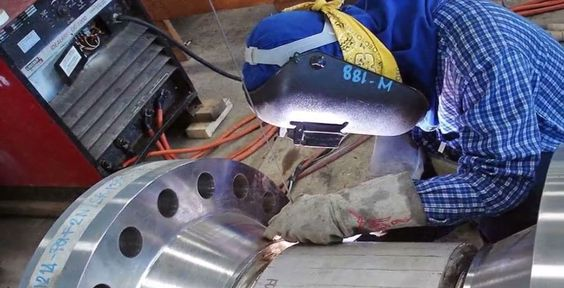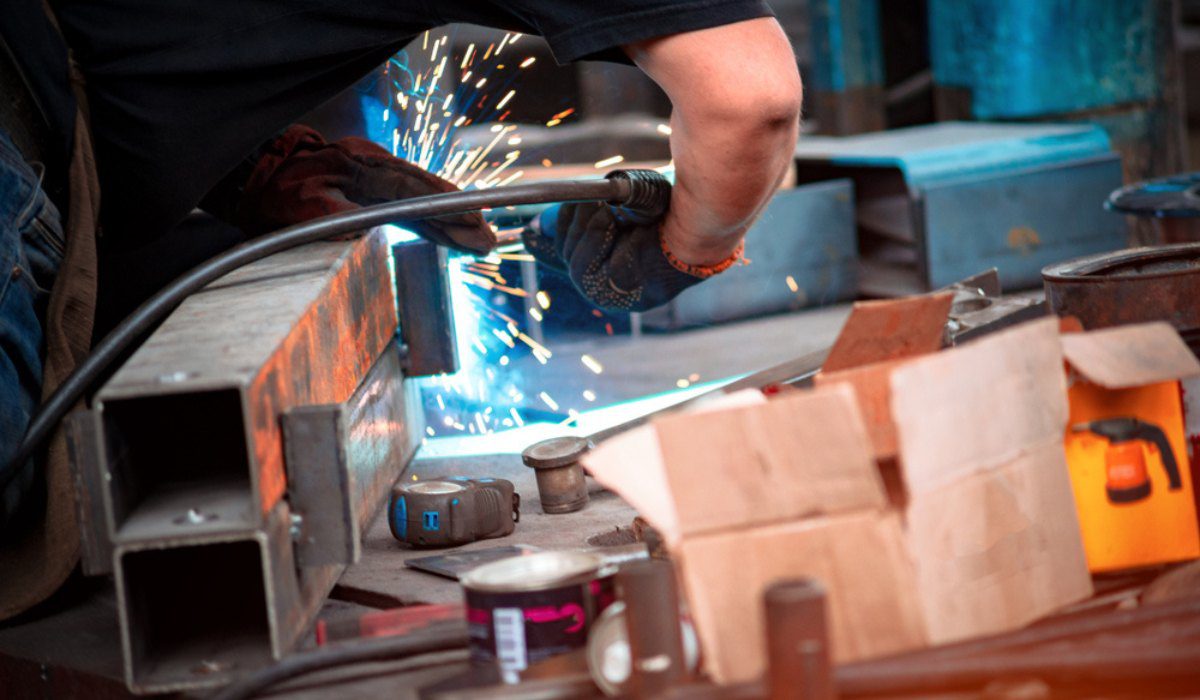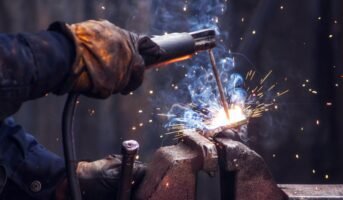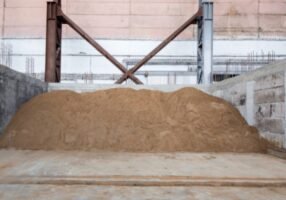Welding is one of the best ways to join metals together. It’s a crucial step in making an item out of sheet metal. Nevertheless, welding defects are possible due to the probability of weld failure. Defects in welding often result from an incompetent welder or some underlying problem with the welding process.
Faulty or subpar welding equipment is the root cause of welding flaws. A weld is considered to have a discontinuity if a fault or imperfection does not render the weld useless. A weld with a discontinuity is thus not always flawed. Depending on the composition of the metal and the method used to weld it, flaws may be of varying sizes, shapes, and locations. An improper welding technique or improper welding patterns are the main reasons. Yet, individual faults in a weldment may also result from various other sources.

Source: Pinterest
See also: What are the different types of welding?
The most typical examples of welding defects
Here are some of the most common types of welding defects.
Welding defects #1: Crack welding
Maybe the most noticeable of all welding flaws are cracks. It’s a flaw formed because of a localised rupture brought on by tensions and cooling. They usually make a big deal because their geometry causes stress at the crack’s end. As a result, cracking in the weldment is common. The kind of fracture that develops depends on the temperature at which it forms.
Weld joints may develop hot cracks during solidification’s cooling and crystallisation phases. Typically, temperatures above 10,000 degrees Celsius are reached at this point. Cold cracks are a “delayed” cracking flaw that appears in weld metal long after solidifying. They may not show up until days after the welding is done.
High welding speed with low current, high residual stress solidification due to shrinkage, and a lack of preheating may all lead to these issues. It’s important to select the suitable metal for the job, and polish its surface before welding. Make sure you’re using the appropriate welding speed and current.
Welding defects #2: Crater
Craters are unique fractures forming in the weld pool after welding but before the connections are fully welded. That usually happens when the crater isn’t filled before breaking the arc.
The tension on the metal may be reduced by holding the torch at an appropriate angle. Wire welding requires a torch angle of 10–15 degrees in the weld direction. To stick weld, keep your arm at an angle of 20 to 30 degrees (in the direction you’re pulling).
Welding defects #3: Undercut
Notches, or undercuts, in the base metal create undercut welding flaws. Length, depth, and sharpness all indicate these imperfections, which form when the base metal is melted away from the weld zone. An undercut welding fault is a thick drop in a straight line parallel to the weldment.
You may do this by slowing down your movement and using less energy. The arc voltage and length may be shortened to achieve the same effect. Generally, a range of 15–30 volts is appropriate for the voltage. Welding arcs shouldn’t be any longer than the core diameter of the electrode.
Welding defects #4: Porosity
Porosity flaws, often known as wormhole welds, arise when air or gas bubbles get trapped in the weld. The combustion of hydrogen, carbon monoxide and steam are common byproducts of the welding process. When seen cross-sectionally, porous weld beads frequently seem like sponges with trapped air bubbles.
They are brought on by insufficient electrode coating or the use of a corroded electrode; the presence of grease, oil, water, rust, or hydrocarbon on the weld surface; and the application of the wrong shielding gas.
Welding defects #5: Spatter
In welding, a process known as “spattering” causes tiny metal particles to be flung forth. These flaws in the weld usually run the whole length of the welded bead. They may also be found in combined forms. The weld current and polarity may be set correctly with the correct shield gas. Cleaning the metal’s surface and increasing the electrode angle may help the welding process go more smoothly.
Welding defects #6: Overlap
Weld overlap occurs when the toe filler material of a weld covers the metal without bonding. The weld pool here is overflowing and goes beyond the toe. When this occurs, the resulting weld metal angle is less than 90 degrees.
Welding defects #7: Lamellar tearing
Welded rolled steel plates often have a flaw where the lamellae pull apart. Its signature flaw is a split that has a stepped, terraced look. In thermal contraction inside the steel plate, lamellar tearing will occur. Moreover, it exists beyond HAZs, often parallel to welds’ fusion limits. Either wait until the very end of the manufacturing process to weld or use high-quality materials and the appropriate welding orientation.
Welding defects #8: Inclusions
Weld inclusions are the result of impurities being caught within the weld. As contaminants are caught within a weld, the strength of the joint drastically decreases. Brazing, stick welding, flux-cored welding, and submerged arc welding are all processes where slag often develops. It’s vital that the slag doesn’t become stuck within the bead and sinks to the bottom of the puddle.
So, it is important to slow down the cooling process of the molten pool. To do so:
- Prepare and clean the base metal well.
- Avoid low amperage settings (prevent the weld pool from cooling too fast).
- Keep the torch moving at the correct speed and angle to avoid combining the weld and slag pools.
Welding defects #9: Under-fill
Under-fill occurs when insufficient weld metal is deposited over the length of a weld, creating a surface that is lower than the neighbouring surface of the parent metal. When it occurs on the outside, this may be seen right away. Excessive welding travel rates or heat inputs may cause underfill.
Welding defects #10: Partial infiltration
Penetration in these faulty welds is measured from the base plate’s top to the weld nugget’s outermost edge. When the groove in the metal is not filled, the weld metal has not fully penetrated the joint thickness, and the weld is incomplete.
It may occur if, for example, the welding metal is too thin or if the welder moves the bead too quickly, preventing enough metal from building up in the joint. Methods for avoiding this include:
- Making sure the surface is smooth before welding.
- Slowing the arc’s travel speed.
- Choosing an appropriate welding current.
Welding defects #11: Mechanical damage
Weld or mechanical damage is a depression in the parent metal’s or weld’s surface. This occurs as a result of careless handling of welding equipment like hammers and grinders. It occurs when excessive force is used when chipping or when the electrode holder is mishandled. Fixing this is as simple as learning how to use welding equipment correctly. Keeping the other piece from accidentally hitting the weld is essential once you’re done welding.
Welding defects #12: Misalignment
During the welding process, the moved weld joint causes these flaws. These issues originate from sloppy plate thickness welding and improper fit-up. The joint’s straightness may be checked during fit-up or tacking, repaired by grinding, and kept in better cosmetic condition by matching the nominal thickness of the two pieces.
FAQs
What is flux when welding?
Flux is a mixture of different minerals, chemicals, and alloying materials. Its main job is to keep oxygen, nitrogen, and other things in the air from contaminating the molten weld metal.
Why should welding be handled by professionals only?
Welding, cutting, and brazing can put your health at risk by exposing you to metal fumes and ultraviolet (UV) radiation. There is a chance of getting burned, hurting your eyes, getting an electric shock, getting cut, or having your toes or fingers crushed.
What are the five causes of a weld crack?
The use of hydrogen when welding iron-based metal is one of the causes. Other causes are stress left over from solidification shrinkage, contamination from base metal, and high welding speed but low current.
| Got any questions or point of view on our article? We would love to hear from you.
Write to our Editor-in-Chief Jhumur Ghosh at jhumur.ghosh1@housing.com |
Housing News Desk is the news desk of leading online real estate portal, Housing.com. Housing News Desk focuses on a variety of topics such as real estate laws, taxes, current news, property trends, home loans, rentals, décor, green homes, home improvement, etc. The main objective of the news desk, is to cover the real estate sector from the perspective of providing information that is useful to the end-user.
Facebook: https://www.facebook.com/housing.com/
Twitter: https://twitter.com/Housing
Email: editor@housing.com











